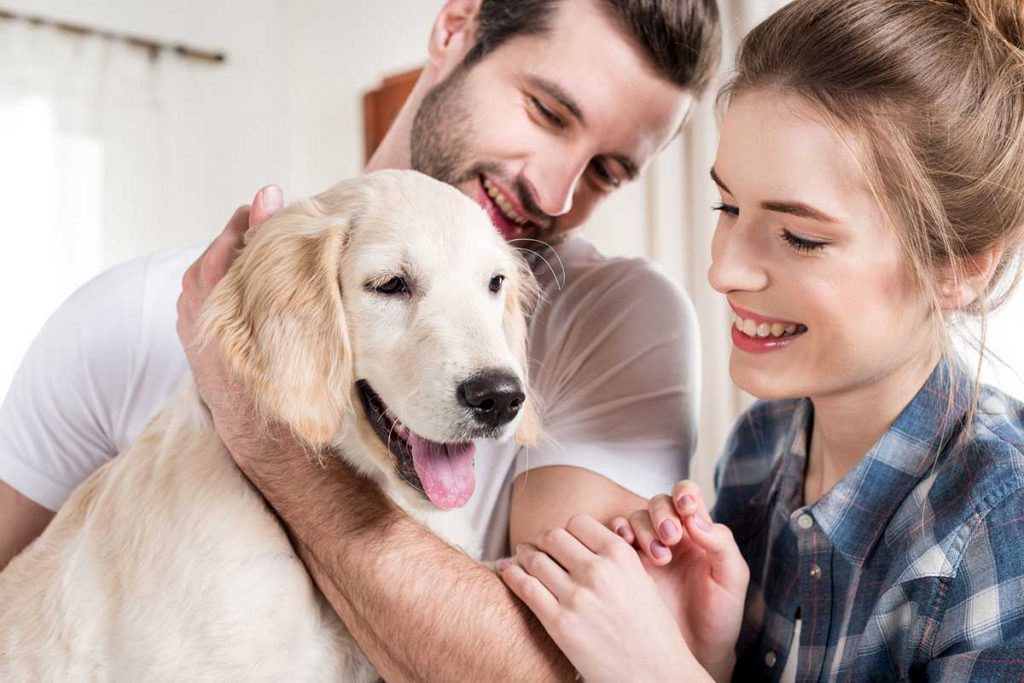If you have had your dog since they were a puppy, you might mark their birthday on your calendar, or at least the day they came to live with you every year.
Did you know that all shelter dogs are given the same birthday?
Shelter dogs all celebrate their birthday on August 1st.
If you got your dog a bit later in their life, not only are you unlikely to know their birthday, you might not even know how old they are.
Fortunately, there are telltale signs that vets and other experts can use to estimate the rough age of a dog. This article will take you through the main methods to estimate your dog’s age.
We will also look at the age-old question of exactly how old your dog is in human years.
What Are The Different Canine Life Stages?
While your vet will probably not be able to tell you the exact age of your dog, they will be able to at least determine what life stage they are in.
Therefore, it is important to understand a bit more about the various life stages that dogs pass through, when they happen, and how long each stage lasts.
1. Puppyhood
While your dog will always be your baby, they are actually only an infant dog for a very small portion of their lives. Depending on their breed, puppyhood can last until your dog is around 6 to 18 months old.
Puppyhood is marked by various different periods and milestones. When they are born, dogs are pretty helpless and they need to stay close to their mothers to feed and regulate their body temperatures.
It is only after two to three weeks that they can start moving around on their own and exploring.
In general, puppies should not really be taken away from their mothers until they are at least eight weeks old or they will struggle to survive.
But from about this age, they develop curious and playful personalities with a penchant for making trouble.
They will also grow quickly until they reach their full size somewhere between 6 and 18 months.
2. Adolescence
After they are no longer puppies, dogs enter a stage of adolescence.
This can start anywhere between 6 and 18 months of age depending on the dog’s breed and will last until they are somewhere between 18 and 24 months old.
This is when reproductive hormones start to kick in, and your dog may start developing challenging behaviors such as marking their territory and pushing your boundaries.
This is an important time for training your dog, and most dogs won’t enter into professions, such as guide dogs or rescue dogs, until after they have passed through this awkward phase.
3. Adulthood
Teenage dogs become adult dogs, and this will form the longest period of their lives.
Starting at anywhere between 18 and 36 months, this stage is when your dog is the most strong, healthy, and energetic.
They also tend to feel more relaxed, so they are better behaved and easier to control.
Interestingly, adult dogs actually tend to have more energy than younger ones.
This means they are better equipped to join you on adventures, but they also need more exercise to stay healthy, happy, and mentally stimulated.
4. Senior Years
When dogs enter the later stages of life, they start to slow down in many ways. They will have less energy overall, and issues such as joint problems may also leave them less active.
It is important to change their diet at this time so they don’t put on excess weight as this can make movement harder.
This stage can start as early as seven years old for large breeds, but it will probably happen more around the 10-year mark for smaller breeds.
This is a good time to start paying extra attention to your dog’s health and keep your eyes peeled for signs of physical pain or issues with their senses.
Based on this description I must be entering my senior years (I turned 50 human years a couple weeks ago). Starting to slow down…check! Less energy overall…check! Joint problems…check!
How To Estimate A Dog’s Age
If you don’t know when your dog was born, how do you estimate how old they are, or at least what life stage they are currently passing through?
The following measures are not foolproof, as just like with humans, the lifestyle of a dog can cause premature aging.
For this reason, you might want to assess your dog’s age when you bring them home, and again after six months once their health has been stabilized in their new environment.
Teeth
Teeth are a good indication of age since teeth development can give a fairly accurate indication of a dog’s age up to about six months.
The baby teeth enter and eventually fall out, and adult teeth grow in during this period. Progressive tartar buildup can generally be tracked until about five years of age.
When dogs enter middle age, they are still adult dogs, but they are closer to the senior stage than their puppy stage.
At this point, their incisors can start to wear down, which is another sign vets will look for. But all of these factors depend on lifestyle.
Daily brushing will keep teeth healthy for longer, while a poor diet can accelerate decay.
Eyes
When looking at older dogs, the eyes can be an excellent indicator of their age. Dogs tend to develop a common eye condition known as lenticular sclerosis somewhere between six and eight years of age.
The presence and progress of this condition can tell you approximately how old your dog is.
At the early stages, lenticular sclerosis looks like thin lines across the lens of the eyes.
As it progresses, the pupil will start to take on a gray, white, or blue tinge. While this can look quite strange, the condition doesn’t negatively affect their vision.
I’ve noticed this condition in my most recent older dogs, Stetson and Linus but I can’t quite recall exactly when the pupil took on the gray color. Raven is 8 years old and I haven’t noticed any changes in her pupil. I’ll try and keep an eye to see when I noticed changes so I can report back here.
Coat
Just like human skin, a dog’s coat is often one of the best signs of aging. Puppies tend to have softer coats that have a different quality from those of older dogs.
This might not be immediately noticeable if you pick up a dog that has had a bad diet or coat care, but if they are still a puppy, their coat should become soft again fairly quickly.
Older dogs will gray around the muzzle and the top of the head, and this is usually a sign they are already in their senior years.
However, lighter-colored dogs that are red, yellow, and/or gold will often start to go white on the top of their head and around their muzzle in earlier middle age.
Again, going back to Stetson and Linus who both had black coats. Stetson started to turn gray around his muzzle in his senior years. Linus on the other hand never started to gray all the way until his passing at around 13 years old.
Behavior
Dogs’ energy levels change throughout their lives and therefore can be a very good indication of age.
This works best with purebred dogs that have predictable behavior patterns. With other mixed-breed dogs, it can be more difficult to know what is normal.
If a dog is slow and takes time to respond to things, they are probably at a later stage in life. Easily excitable dogs, which may not be able to control their bladder when excited, are often adolescents.
How To Calculate Your Dog’s Age In Human Years
It’s good to know roughly how old your dog is based on their teeth, coat, behavior, etc., but how do you calculate your dog’s age in human years and determine what comparable stage of life your dog is in?
Is your four-month old puppy in the terrible twos and your two-year-old dog suffering through tough teenage years?
We’ve all heard that one dog year is the equivalent of seven human years. That roughly aligns with the general lifespan of dogs compared to humans.
However, it does not reflect the different life stages that dogs pass through.
Dogs mature more quickly than humans in their early years and then tend to stay at a healthy “adult dog” stage for longer before moving into their senior years.
But once they start to develop senior issues, they age much more quickly than humans.
Veterinarians would say that a one-year-old dog is already the equivalent of a 15-year-old human, and by the time they are two years old, they are already 25 in human years or a fully-fledged adult.
But after this rapid growth, their rate of aging slows down rapidly. In terms of lifespan, they age around four human years for every dog year.
As for when they become seniors, it depends a lot on the breed of the dog. Bigger dogs tend to have shorter lifespans and start to develop problems such as vision and join issues earlier.
German shepherds, for instance, have a lifespan of about 10 years, and Labradors live for around 12 years.
Smaller dogs live longer, and they will be happily nipping at your heels until a slightly older age.
Dachshunds will often live to around 15 years of age, while smaller Chihuahuas can live for up to 20 years.
The Verdict
If you don’t know when your dog was born, there are other methods you can use to estimate how old they are.
Based principally on the state of their teeth, eyes, coat, and behavior, a vet should be able to tell you at least what life stage your dog is in, if not their exact age.
The main life stages for most dogs are as follows:
- Puppy: 6 to 18 months old, depending on the breed
- Adolescence: 18 to 24 months old
- Adulthood: Begins at 18 to 36 months
- Senior: Begins at around the 7-to-10-year mark
Do you need to choose a birthday for your dog?
Why not choose the day they came to stay with you, or the universal dog birthday of August 1st?
We got Linus when he was a puppy when we got him. We guessed he was 2 months old and just rolled the clock back 2 months. His gotcha day was January 7th and we declared his birthday to be November 7th.
How about you?
How did you choose your rescue pups birthday?
Tell us about your dog in the comment section below.

